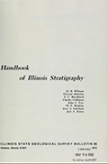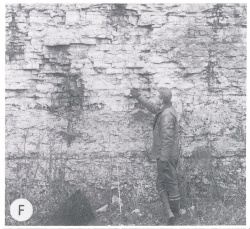Historical:Quimbys Mill Formation
Lithostratigraphy: Ottawa Limestone Megagroup >>Platteville Group >>Plattin Subgroup >>Quimbys Mill Formation
Chronostratigraphy: Paleozoic Erathem >>Ordovician System >>Champlainian Series >>Blackriveran Stage
Allostratigraphy: Tippecanoe Sequence
Authors
H. B. Willman and T. C. Buschbach
Name Origin
The Quimbys Mill Formation (Agnew and Heyl, 1946, p. 1585), which overlies the Nachusa Formation, is named for Quimby's Mill near Etna, Lafayette County, Wisconsin (SE SE 11, 1N-1E) (Templeton and Willman, 1963, p. 235).
Type Section
The type section of the Quimbys Mill Formation is a small quarry near Quimby's Mill, where the formation is 12 feet thick.
Other Names
The Quimbys Mill Formation is equivalent to the upper member of the Tyrone Formation in Kentucky and the upper member of the Carters Limestone in Tennessee.
Extent and Thickness
The Quimbys Mill is close to 12 feet thick throughout the northern outcrop area in Illinois and 30-35 feet thick in the southern outcrop area in Illinois and Missouri, but it locally thins in subsurface and in Sangamon County is only 3 feet thick. The Quimbys Mill extends eastward into Ontario, but it appears to be absent in the New York section.
Stratigraphic Position
The Quimbys Mill has a sharp contact, probably a diastem, with the underlying Nachusa, and its top is a ferruginous, pitted surface that is a regional unconformity with low relief. The Quimbys Mill is overlain by the Spechts Ferry Formation, the basal formation of the Galena Group, in extreme northwestern Illinois and in Calhoun County, but the Spechts Ferry thins out eastward and is not present in the northern outcrop area or in subsurface in eastern Illinois, where the Guttenberg Formation overlies the Quimbys Mill Formation.
Description
In the type area and in a small exposure in extreme northwestern Illinois, the Quimbys Mill is brown lithographic limestone with brown shale partings. Because of its pronounced conchoidal fracture it is known as the "Glassrock." In the outcrop area in central northern Illinois, it is light brown, dense, very fine-grained, slightly argillaceous dolomite that weathers yellow-buff (fig. O-2F). It is thin to medium bedded and has thin brown shale partings. In the southern outcrop area the formation is fine-grained to lithographic limestone, the shale partings are greenish gray, the bedding and weathered surfaces are relatively smooth, and it contains some thin layers of conglomerate, fossil debris, and bentonite. The Quimbys Mill Formation is differentiated into three members; the Hazel Green (at the base) is thick bedded, slightly shaly, and weathers white; the Shullsburg is thin bedded and shaly; and the Strawbridge (at the top) is thick bedded, slightly shaly, and finely fucoidal.
Fossils
The Quimbys Mill is generally fossiliferous, containing brachiopods (especially Strophomena), bryozoans, horn corals, trilobites, and the ostracode Eoleperditia.
References
AGNEW, A. F., and A. V. HEYL, JR., 1946, Quimbys Mill, new member of Platteville Formation, Upper Mississippi Valley: American Association of Petroleum Geologists Bulletin, v. 30, p. 1585-1587.
TEMPLETON, J. S., and H. B. WILLMAN, 1963, Champlainian Series (Middle Ordovician) in Illinois: Illinois State Geological Survey Bulletin 89, 260 p.
ISGS Codes
| Stratigraphic Code | Geo Unit Designation |
|---|---|

